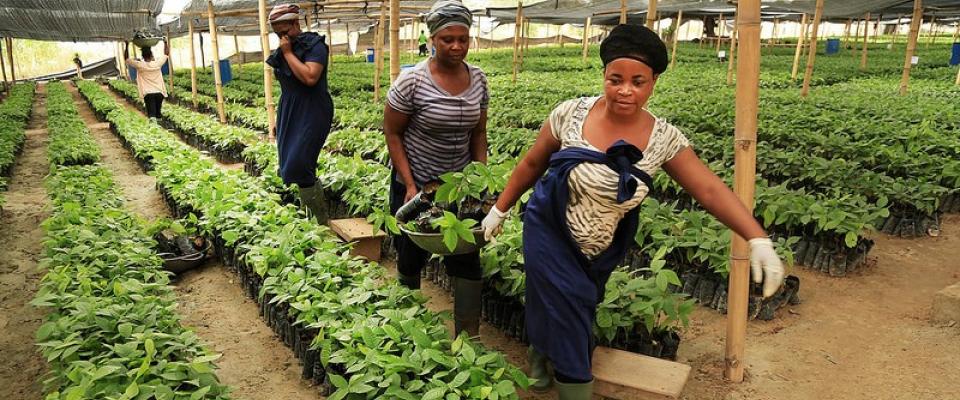Regional Centre of Phytosanitary Excellence
Enhance the capacity of national phytosanitary systems in East Africa to effectively implement international phytosanitary standards to be able to compete in international markets, and protect agriculture and natural resources.
A result story on the project is available here.
Plant health system is not only a safeguard of human health but also a facilitator of international trade in horticulture products. Results from IPPC’s Phytosanitary Capacity Evaluation (PCE) tool have repeatedly shown there is inadequate capacity amongst African countries to apply international phytosanitary standards in their countries. Lack of capacity has led to increased crop loss during production and post-harvest hence decreasing the ability of particularly East African countries to meet the targets of food safety and security. Further this has hindered the region's access to international trade, notably in horticultural produce. In order to protect agriculture at both national and regional levels, national authorities recognized a need for a coordinated phytosanitary capacity development approach. In this context, the Kenya Plant Health Inspectorate Service (KEPHIS) submitted a project grant proposal to establish a Centre of Phytosanitary Excellence (COPE) as a coordinated mechanism to enhance the capacity of national phytosanitary systems hence increase the ability of African countries to meet international phytosanitary standards. COPE was implemented and managed in Kenya, while beneficiary countries also included Burundi, Ethiopia, Malawi, Mozambique, Rwanda, Seychelles, Tanzania, Uganda, Zambia and Zimbabwe. The Project Proposal was approved and fully funded by the STDF Secretariat.
A dedicted project website can be found here.
COPE became a major channel of communication between relevant stakeholders at all levels
COPE's Secretariat comprised a wide range of representatives from NPPOs, African Union, IPPC, FAO, USAID and CABI with an aim to build and maintain partnerships with national, regional and international organizations, including universities, regional economic bodies, international technical agencies, and development partners. Training materials and online resources were continuously disseminated among listed stakeholders. Such multi-sectoral approached enhanced the efficiency of phytosanitary capacity development.
Seven short-in and university courses were developed and delivered
A regional survey as well as consultations with NPPOs helped identify specific capacity development needs. As a result, As a result, four short in-service courses and three university level courses were designed. The curriculum of the short-in courses covered thematic topics on phytosanitary systems improvement and management, skills enhancement, certification and import verification procedures. Courses at the University level were integrated in existing plant protection courses, concentrating mostly on certification practices in accordance with the phytosanitary measures. The training program contributed to the creation of the working group on the phytosanitary regulations for the maize and green beans. Additionally, trainees were offered a course on business administration and teaching skills to improve broader institutional capacity.
A coordinating Pest Risk Analysis (PRA) Unit was established
Pest Risk Analysis was identified as a tool to choose the severity and nature of phytosanitary measures and reduce the spread of pests through trade. COPE facilitated a regional network of pest risk analysts and lobbied for creation of PRA units in countries where such agencies were not present. COPE established a partnership with regional initiatives such as the East African Phytosanitary Information Committee (EAPIC) to develop and promote avenues for sharing pest information. Access to reliable information on pesticide residues was constricted in a number of East African countries, therefore, COPE engaged regional pest analysts in updating the pest lists for prioritized commodities.
A training resource centre and an online-import requirement database were launched
At the training resource centre, new equipment and resource materials were provided for PRA experts and National Plant Protection analysts to enhance effectiveness of the capacity building program. A new generation of computers and microscopes was delivered in order to conduct a training course for KEPHIS staff. All trainees were also taught on the efficient use of the new software and the platform for the documentation exchange.
A project website “AfricaCOPE.org” was registered and activated
A dedicated project website enabled the distribution of various promotional materials produced, including posters, banners and brochures. The website has also become a platform for awareness raising activities, channelling individual course modules and providing access to new publications/research works on phytosanitary issues.
Institutional model is a key to practical feasibility of COPE
The desired level of SPS capacity in African countries can only be achieved through partnerships between government, private sector and international organizations on national and regional levels. While COPE was implemented as a department of the Kenya Plant Health Inspectorate Service (KEPHIS), the organisational structure ensured collaboration and synergy with both national and international bodies involved in the phytosanitary field. Further cross-sectoral cooperation in the plant protection sector is recommended in order to increase efficiency of the SPS capacity building initiatives and their sustainability after the phase out of grant resources.
Adapt the scope of capacity building activities to specific needs of regional phytosanitary communities
The implementation stage of the project was focused on core training activities and the development of the PRU unit. However, national NPPOs as well as international partners signalled the importance of additional issues that were not prioritized by the COPE work plan. Additional financial and human capital resources are to be raised for further expansion of outputs and geographical coverage of COPE activities.
Promotion of COPE's legal status could improve efficiency and coordination of all on-going phytosanitary activities
Given a strong partnership with public, private and international stakeholders in the plant protection field, COPE has a potential to become the main facilitator of any related initiatives in the region. The adoption of an independent legal entity status is required to mainstream phytosanitary programs. Additionally, continuous collaboration with COMESA, FAO, IPPC and national regulatory organizations will ensure efficiency and timely coordination of PRA units, training initiatives and related researches in the academic field.
| Attachment | Size |
|---|---|
| 801.46 KB | |
| 77.78 KB |

